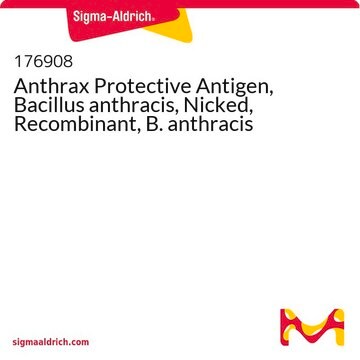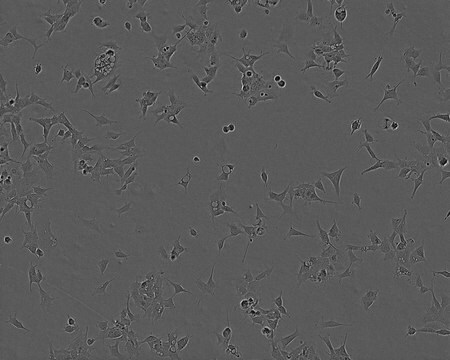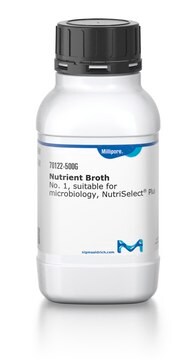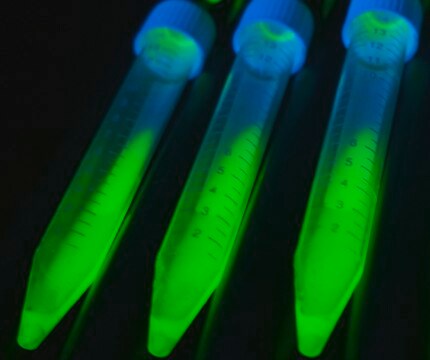176905
Anthrax Protective Antigen, Bacillus anthracis, Recombinant, B. anthracis
Anthrax Protective Antigen, Bacillus anthracis, Recombinant, is the protective antigen that mediates the entry of anthrax lethal factor and edema factor into the target cell.
Synonym(s):
Anthrax PA
Sign Into View Organizational & Contract Pricing
All Photos(1)
About This Item
UNSPSC Code:
12352202
Recommended Products
Quality Level
form
lyophilized
manufacturer/tradename
Calbiochem®
storage condition
OK to freeze
shipped in
ambient
storage temp.
2-8°C
General description
Recombinant, Bacillus anthracis anthrax protective antigen expressed in a special strain of B. anthracis. One of three protein components of anthrax toxin produced by the pathogenic bacterium, Bacillus anthracis. Central moiety that mediates entry of lethal factor (LF) and edema factor (EF) into the target cell. PA83 binds to the cell surface via a type I membrane receptor with a von Willebrand factor A domain, known as anthrax toxin receptor. PA83 is proteolytically activated in vivo by a furin-like protease to produce a 63 kDa protein (PA63). PA63 self-associates to form a heptameric, cation-selective, voltage-gated, membrane channel that subsequently binds to LF and/or EF. Cleavage of the 20 kDa fragment from PA83 is necessary for binding of protective antigen to LF and EF.
Recombinant, Bacillus anthracis anthrax protective antigen expressed in a specialized strain of B. anthracis. One of the three protein components of Anthrax toxin, protective antigen (PA) is the central moiety that mediates the entry of lethal factor and edema factor into the target cell. PA binds to the cell surface via a type I membrane protein with a von Willebrand factor A domain called anthrax toxin receptor. After proteolytic activation to a 63 kDa fragment, PA self-associates to form a heptameric cation-selective, voltage-gated membrane channel.
Biochem/physiol Actions
Cell permeable: no
Primary Target
Type I membrane protein with a von Willebrand factor A domain called anthrax toxin receptor
Type I membrane protein with a von Willebrand factor A domain called anthrax toxin receptor
Product does not compete with ATP.
Reversible: no
Packaging
yes
Warning
Toxicity: Standard Handling (A)
Physical form
Lyophilized from 50 mM NaCl, 5 mM HEPES, pH 7.5.
Reconstitution
Following reconstitution aliquot and freeze (-20°C). Avoid freeze/thaw cycles of solutions. Stock solutions are stable for up to 6 months at -20°C.
Reconstitute in 100 µl sterile, distilled H₂O to yield a final concentration of 1 mg/ml.
Analysis Note
Single major band by SDS-PAGE. Several smaller minor components are apparent that may represent cleavage fragments of the PA.
Other Notes
Mogridge, J., et al. 2002. Biochemistry41, 1079.
Nassi, S., et al. 2002. Biochemistry41, 1445.
Ahuja, N., et al. 2001. Biochem. Biophys. Res. Commun.286, 6.
Bradley, K.A., et al. 2001. Nature414, 225.
Brossier, F., and Mock, M. 2001. Toxicon39, 1747.
Nassi, S., et al. 2002. Biochemistry41, 1445.
Ahuja, N., et al. 2001. Biochem. Biophys. Res. Commun.286, 6.
Bradley, K.A., et al. 2001. Nature414, 225.
Brossier, F., and Mock, M. 2001. Toxicon39, 1747.
Legal Information
CALBIOCHEM is a registered trademark of Merck KGaA, Darmstadt, Germany
Storage Class Code
11 - Combustible Solids
WGK
WGK 1
Flash Point(F)
Not applicable
Flash Point(C)
Not applicable
Certificates of Analysis (COA)
Search for Certificates of Analysis (COA) by entering the products Lot/Batch Number. Lot and Batch Numbers can be found on a product’s label following the words ‘Lot’ or ‘Batch’.
Already Own This Product?
Find documentation for the products that you have recently purchased in the Document Library.
Our team of scientists has experience in all areas of research including Life Science, Material Science, Chemical Synthesis, Chromatography, Analytical and many others.
Contact Technical Service








